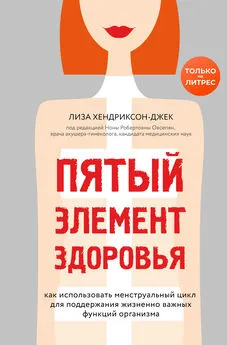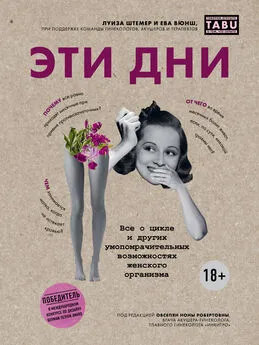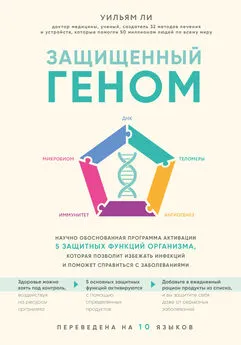Лиза Хендриксон-Джек - Пятый элемент здоровья. Как использовать менструальный цикл для поддержания жизненно важных функций организма
- Название:Пятый элемент здоровья. Как использовать менструальный цикл для поддержания жизненно важных функций организма
- Автор:
- Жанр:
- Издательство:Литагент 5 редакция
- Год:2020
- Город:Москва
- ISBN:978-5-04-104425-1
- Рейтинг:
- Избранное:Добавить в избранное
-
Отзывы:
-
Ваша оценка:
Лиза Хендриксон-Джек - Пятый элемент здоровья. Как использовать менструальный цикл для поддержания жизненно важных функций организма краткое содержание
«Почти» – потому что у женщин есть пятый показатель здоровья, на который, к сожалению, все еще мало кто обращает внимание, – это менструальный цикл. Короткий или длинный, регулярный или непредсказуемый – цикл может быть очень разным, и каждый его параметр, каждое изменение служат индикатором той или иной проблемы в организме. Планируете вы беременность или нет, овуляция имеет значение для поддержания здоровья.
Автор этой книги расскажет, что именно влияет на состояние менструального цикла, и научит вас составлять его график для максимально точного и удобного отслеживания различных изменений и контроля здоровья.
Пятый элемент здоровья. Как использовать менструальный цикл для поддержания жизненно важных функций организма - читать онлайн бесплатно ознакомительный отрывок
Интервал:
Закладка:
12. Fehring, Richard J., Mary Schneider, and Kathleen Raviele. “Variability in the phases of the menstrual cycle.” Journal of Obstetric, Gynecologic, & Neonatal Nursing 35, no. 3 (2006): 376–384.
13. Там же; Harlow, Siobán D., and Sara A. Ephross. “Epidemiology of menstruation and its relevance to women’s health.” Epidemiologic Reviews 17, no. 2 (1995): 269; Lenton, Elizabeth A., Brut Landgren, and Lynne Sexton. “Normal variation in the length of the luteal phase of the menstrual cycle: identification of the short luteal phase.” BJOG: An International Journal of Obstetrics and Gynaecology 91, no. 7 (1984): 685–689; Crawford, Natalie M., David A. Pritchard, Amy H. Herring, and Anne Z. Steiner. “A prospective evaluation of luteal phase length and natural fertility.” Fertility and Sterility (2017); Mumford, Sunni L., Anne Z. Steiner, Anna Z. Pollack, Neil J. Perkins, Amanda C. Filiberto, Paul S. Albert, Donald R. Mattison, Jean Wactawski-Wende, and Enrique F. Schisterman. “The utility of menstrual cycle length as an indicator of cumulative hormonal exposure.” The Journal of Clinical Endocrinology & Metabolism 97, no. 10 (2012): E1871–E1879; Cole, Laurence A., Donald G. Ladner, and Francis W. Byrn. “The normal variabilities of the menstrual cycle.” Fertility and Sterility 91, no. 2 (2009): 522–527; Hilgers, Thomas W. (2004). The Medical & Surgical Practice of NaProTechnology. Omaha, NE: Pope Paul VI Institute Press, 203–205; Landgren, B.-M., A.-L. Unden, and Egon Diczfalusy. “Hormonal profile of the cycle in 68 normally menstruating women.” Acta Endocrinologica 94, no. 1 (1980): 89–98.
14. Mesen, Tolga B., and Steven L. Young. “Progesterone and the luteal phase: a requisite to reproduction.” Obstetrics and Gynecology Clinics of North America 42, no. 1 (2015): 135.
15. Strauss, Jerome F., and Robert L. Barbieri (2009). Yen & Jaffe’s Reproductive Endocrinology: Physiology, Pathophysiology, and Clinical Management, 6th edition. Philadelphia, PA: Elsevier, 213–214; Tabibzadeh, S., and A. Babaknia. “The signals and molecular pathways involved in implantation, a symbiotic interaction between blastocyst and endometrium involving adhesion and tissue invasion.” MHR: Basic Science of Reproductive Medicine 1, no. 4 (1995): 179–202; Matus, Geraldine (Ed.). “Female sexual anatomy and physiology.” Justisse HRHP Training Program. Justisse College. Accessed February 20, 2017. www.justisse.ca/index.php/college/courseware/page/1059.
16. Gnoth, Christian, P. Frank-Herrmann, A. Schmoll, E. Godehardt, and G. Freundl. “Cycle characteristics after discontinuation of oral contraceptives.” Gynecological Endocrinology 16, no. 4 (2002): 307–317.
17. Qublan, H., Z. Amarin, M. Nawasreh, F. Diab, S. Malkawi, N. Al-Ahmad, and M. Balawneh. “Luteinized unruptured follicle syndrome: incidence and recurrence rate in infertile women with unexplained infertility undergoing intrauterine insemination.” Human Reproduction 21, no. 8 (2006): 2110–2113.
18. Cutler, Winnifred Berg. “Lunar and menstrual phase locking.” American Journal of Obstetrics and Gynecology 137, no. 7 (1980): 834–839.
19. Law, Sung Ping. “The regulation of menstrual cycle and its relationship to the moon.” Acta Obstetricia et Gynecologica Scandinavica 65, no. 1 (1986): 45–48.
20. Dewan, Edmond M. “On the possibility of a perfect rhythm method of birth control by periodic light stimulation.” American Journal of Obstetrics and Gynecology 99, no. 7 (1967): 1016–1019; Lin, May C., Daniel F. Kripke, Barbara L. Perry, and Sarah L. Berga. “Night light alters menstrual cycles.” Psychiatry Research 33, no. 2 (1990): 135–138; Rex, Katharine M., Daniel F. Kripke, Roger J. Cole, and Melville R. Klauber. “Nocturnal light effects on menstrual cycle length.” The Journal of Alternative and Complementary Medicine 3, no. 4 (1997): 387–390.
21. Rex, Katharine M., Daniel F. Kripke, Roger J. Cole, and Melville R. Klauber. “Nocturnal light effects on menstrual cycle length.” The Journal of Alternative and Complementary Medicine 3, no. 4 (1997): 387–390; Lin, May C., Daniel F. Kripke, Barbara L. Perry, and Sarah L. Berga. “Night light alters menstrual cycles.” Psychiatry Research 33, no. 2 (1990): 135–138.
22. Harlow, Siobán D., and Genevieve M. Matanoski. “The association between weight, physical activity, and stress and variation in the length of the menstrual cycle.” American Journal of Epidemiology 133, no. 1 (1991): 38–49.
Глава 5
1. “UNESCO UIS. Literacy.” Accessed November 11, 2017. uis.unesco.org/en/topic/literacy.
2. Global Industry Analysis, Size, Share, Growth, Trends and Forecast 2015–2023. “Oral Contraceptive Pills Market – Global Industry Analysis, Size, Share, Growth, Trends and Forecast 2015–2023.” Accessed November 13, 2017. www.transparencymarketresearch.com/oral-contraceptive-pills-market.html.
3. “Body Literacy – Justisse for Women.” Accessed August 25, 2018. www.justisse.ca/index.php/pages/page/body-literacy.
4. Frank-Herrmann, P., J. Heil, C. Gnoth, E. Toledo, S. Baur, C. Pyper, E. Jenetzky, T. Strowitzki, and G. Freundl. “The effectiveness of a fertility awareness based method to avoid pregnancy in relation to a couple’s sexual behaviour during the fertile time: a prospective longitudinal study.” Human Reproduction (2007).
5. Urrutia, Rachel Peragallo, Chelsea B. Polis, Elizabeth T. Jensen, Margaret E. Greene, Emily Kennedy, and Joseph B. Stanford. “Effectiveness of fertility awareness-based methods for pregnancy prevention: a systematic review.” Obstetrics & Gynecology 132, no. 3 (2018): 591–604.
6. Hilgers, Thomas W. (2004). The Medical & Surgical Practice of NaPro Technology. Omaha, NE: Pope Paul VI Institute Press, 67–72; Matus, Geraldine. “Justisse Method: Fertility Awareness and Body Literacy: A User’s Guide.” Justisse– Healthworks for Women (2009): 15–17.
7. McNab, Brian K. “On the utility of uniformity in the definition of basal rate of metabolism.” Physiological Zoology 70, no. 6 (1997): 718–720; Henry, C.J.K. “Basal metabolic rate studies in humans: measurement and development of new equations.” Public Health Nutrition 8, no. 7a (2005): 1133–1152.
8. Hilgers, Thomas W. (2010). The NaPro Technology Revolution: Unleashing the Power in a Woman’s Cycle. New York, NY: Beaufort Books, 122–156.
9. Su, Hsiu-Wei, Yu-Chiao Yi, Ting-Yen Wei, Ting-Chang Chang, and Chao-Min Cheng. “Detection of ovulation, a review of currently available methods.” Bioengineering & Translational Medicine (2017): 238–246.
10. Kambic, R.T., and V. Lamprecht. “Calendar rhythm efficacy: a review.” Advances in Contraception 12, no. 2 (1996): 123–128.
11. Brayer, Franklin T., Leonard Chiazze, and Benedict J. Duffy. “Calendar rhythm and menstrual cycle range.” Fertility and Sterility 20, no. 2 (1969): 279–288.
Глава 6
1. Kim, Brian. “Thyroid hormone as a determinant of energy expenditure and the basal metabolic rate.” Thyroid 18, no. 2 (2008): 141–144; Al-Adsani, Hana, L. John Hoffer, and J. Enrique Silva. “Resting energy expenditure is sensitive to small dose changes in patients on chronic thyroid hormone replacement.” The Journal of Clinical Endocrinology & Metabolism 82, no. 4 (1997): 1118–1125.
2. Giorda, Carlo B., Paolo Carnà, Francesco Romeo, Giuseppe Costa, Barbara Tartaglino, and Roberto Gnavi. “Prevalence, incidence and associated comorbidities of treated hypothyroidism: an update from a European population.” European Journal of Endocrinology 176, no. 5 (2017): 533–542; Vanderpump, Mark P.J., and W. Michael G. Tunbridge. “Epidemiology and prevention of clinical and subclinical hypothyroidism.” Thyroid 12, no. 10 (2002): 839–847.
3. Tunbridge, W.M.G., D.C. Evered, R. Hall, D. Appleton, M. Brewis, F. Clark, J. Grimley Evans, E. Young, T. Bird, and P.A. Smith. “The spectrum of thyroid disease in a community: the Whickham survey.” Clinical Endocrinology 7, no. 6 (1977): 481–493; Canaris, Gay J., Neil R. Manowitz, Gilbert Mayor, and E. Chester Ridgway. “The Colorado thyroid disease prevalence study.” Archives of Internal Medicine 160, no. 4 (2000): 526–534.
4. Garber, Jeffrey R., Rhoda H. Cobin, Hossein Gharib, James V. Hennessey, Irwin Klein, Jeffrey I. Mechanick, Rachel Pessah-Pollack, Peter A. Singer, and Kenneth A. Woeber for the American Association of Clinical Endocrinologists and American Thyroid Association Taskforce on Hypothyroidism in Adults. “Clinical practice guidelines for hypothyroidism in adults: cosponsored by the American Association of Clinical Endocrinologists and the American Thyroid Association.” Thyroid 22, no. 12 (2012): 1200–1235; Wartofsky, Leonard, and Richard A. Dickey. “The evidence for a narrower thyrotropin reference range is compelling.” The Journal of Clinical Endocrinology & Metabolism 90, no. 9 (2005): 5483–5488.
5. Negro, Roberto, and Alex Stagnaro-Green. “Diagnosis and management of subclinical hypothyroidism in pregnancy.” The BMJ 349 (2014): 1–10.
6. Joshi, J.V., S.D. Bhandarkar, M. Chadha, D. Balaiah, and R. Shah. “Menstrual irregularities and lactation failure may precede thyroid dysfunction or goitre.” Journal of Postgraduate Medicine 39, no. 3 (1993): 137–41.
7. Krassas, Gerasimos E. “Thyroid disease and female reproduction.” Fertility and Sterility 74, no. 6 (2000): 1063–1070.
8. Krassas, G.E., Kris Poppe, and Daniel Glinoer. “Thyroid function and human reproductive health.” Endocrine Reviews 31, no. 5 (2010): 702–755.
9. Krassas, Gerasimos E. “Thyroid disease and female reproduction.” Fertility and Sterility 74, no. 6 (2000): 1063–1070.
10. Jacobson, Melanie H., Penelope P. Howards, Lyndsey A. Darrow, Juliana W. Meadows, James S. Kesner, Jessica B. Spencer, Metrecia L. Terrell, and Michele Marcus. “Thyroid hormones and menstrual cycle function in a longitudinal cohort of premenopausal women.” Paediatric and Perinatal Epidemiology (2018): 1–10.
11. Hess, Sonja Y. “The impact of common micronutrient deficiencies on iodine and thyroid metabolism: the evidence from human studies.” Best Practice & Research: Clinical Endocrinology & Metabolism 24, no. 1 (2010): 117–132.
12. Peckham, Stephen, David Lowery, and Sarah Spencer. “Are fluoride levels in drinking water associated with hypothyroidism prevalence in England? A large observational study of GP practice data and fluoride levels in drinking water.” Journal of Epidemiol Community Health 69, no. 7 (2015): 619–624.
13. Pearce, Elizabeth N., and Lewis E. Braverman. “Environmental pollutants and the thyroid.” Best Practice & Research; Clinical Endocrinology & Metabolism 23, no. 6 (2009): 801–813; Kashiwagi, Keiko, Nobuaki Furuno, Shigeyuki Kitamura, Shigeru Ohta, Kazumi Sugihara, Kozo Utsumi, Hideki Hanada, Kikuyo Taniguchi, Ken-ichi Suzuki, and Akihiko Kashiwagi. “Disruption of thyroid hormone function by environmental pollutants.” Journal of Health Science 55, no. 2 (2009): 147–160.
14. Rice, Kevin M., Ernest M. Walker Jr., Miaozong Wu, Chris Gillette, and Eric R. Blough. “Environmental mercury and its toxic effects.” Journal of Preventive Medicine and Public Health 47, no. 2 (2014): 74–83.
15. Liontiris, Michael I., and Elias E. Mazokopakis. “A concise review of Hashimoto thyroiditis (HT) and the importance of iodine, selenium, vitamin D and gluten on the autoimmunity and dietary management of HT patients. Points that need more investigation.” Hellenic Journal of Nuclear Medicine 20, no. 1 (2017): 51–56.
16. Fröhlich, Eleonore, and Richard Wahl. “Thyroid autoimmunity: role of anti-thyroid antibodies in thyroid and extra– thyroidal diseases.” Frontiers in Immunology 8 (2017): 521: 1–16.
Читать дальшеИнтервал:
Закладка:









